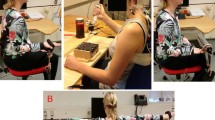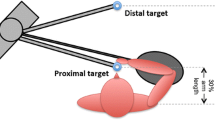Summary
Standardized and machine-paced work tasks at a packing machine were examined to evaluate interindividual variability of muscle activity patterns. Ten trained female workers, without musculo-skeletal complaints at the time of the recording, performed the work tasks while electromyographic (EMG) recordings were obtained from both upper trapezius muscles. Static muscle activity and periods of between 0.2 and 2 s duration with low muscle activity, EMG gaps, were analysed. Complaints of muscular fatigue, soreness or pain in the neck and shoulders during the last 12 months were recorded. The level of static muscle activity was 1.6 (range 0.4 to 2.5) per cent of maximal voluntary contraction and median number of EMG gaps was 4.8 (range 0.8 to 20) per minute. Workers with previous episodes of complaints (five subjects) had higher levels of static muscle activity and fewer EMG gaps than workers without such episodes (p < 0.05, Wilcoxon 2-sample test, one-tailed). Considerable interindividual variability of muscle activity patterns was found in spite of stereotyped work. No causal relations may be inferred from the correlation between the level of trapezius activity and complaints, though it indicates that individual, inexpedient muscle activity patterns may constitute an important risk factor for development of musculo-skeletal complaints.
Similar content being viewed by others
References
Aarås A, Westgaard RH (1987) Further studies of postural load and musculo-skeletal injuries of workers at an electromechanical assembly plant. Appl Ergonomics 18:211–219
Antti CJ (1977) Relationship between time means of external load and EMG amplitude in long term myoelectric studies. Electromyogr Clin Neurophysiol 17:45–53
Bjelle A, Hagberg M, Michaelson G (1981) Occupational and individual factors in acute shoulder-neck disorders among industrial workers. Br J Ind Med 38:356–363
Björkstén M, Jonsson B (1977) Endurance limit of force in long-term intermittent static contractions. Scand J Work Environ Health 3:23–27
Christensen H (1986) Muscle activity and fatigue in the shoulder muscles of assembly-plant employees. Scand J Work Environ Health 12:582–587
Erdelyi A, Sihvonen T, Helin P, Hänninen O (1988) Shoulder strain in keyboard workers and its alleviation by arm supports. Int Arch Occup Environ Health 60:119–124
Hagberg M (1984) Occupational musculoskeletal stress and disorders of the neck and shoulder: a review of possible pathophysiology. Int Arch Occup Environ Health 53:269–278
Hagberg M, Sundelin G (1986) Discomfort and load on the upper trapezius muscle when operating a wordprocessor. Ergonomics 29:1637–1645
Hagberg M, Wegman DH (1987) Prevalence rates and odds ratios of shoulder-neck diseases in different occupational groups. Br J Ind Med 44:602–610
Hennig R, Lømo T (1985) Firing patterns of motor units in normal rats. Nature 314:164–166
Hennig R, Lømo T (1987) Gradation of force output in normal fast and slow muscles of the rat. Acta Physiol Scand 130:133–142
Jonsson B (1978) Kinesiology — with special reference to electromyographic kinesiology. In: Cobb WA, Van Duijn H (eds) Contemp Clin Neurophysiol 34:417–428. Elsevier Scientific Publishing Company, Amsterdam
Jonsson B (1982) Measurement and evaluation of local muscular strain in the shoulder during constrained work. J Hum Ergol 11:73–88
Kilbom Å, Persson J, Jonsson BG (1986) Disorders of the cervicobrachial region among female workers in the electronics industry. Int J Ind Ergonomics 1:37–47
Kilbom Å, Persson J (1987) Work technique and its consequences for musculoskeletal disorders. Ergonomics 30:273–279
Luopajärvi T, Kuorinka I, Virolainen M, Holmberg M (1979) Prevalence of tenosynovitis and other injuries of the upper extremities in repetitive work. Scand J Work Environ Health [Suppl 3] 6:48–55
Milner-Brown HS, Stein RB, Yemm R (1973) The olderly recruitment of human motor units during voluntary isometric contractions. J Physiol 230:359–370
Nowlin TP, Bailey JO (1985) Evaluation of the effect of anxiety on the masseteric silent period duration. J Oral Rehabil 12:119–122
Parenmark G, Engvall B, Malmkvist A-K (1988) Ergonomic on-the-job training of assembly workers. Appl Ergonomics 19:143–146
Punnett L, Robins JM, Wegman, Keyserling WM (1985) Soft tissue disorders in the upper limbs of female garment workers. Scand J Work Environ Health 11:417–425
Rohmert W (1960) Ermittlung von Erholungspausen für statische Arbeit des Menschen. Int Z Physiol Einschl Arbeitsphysiol 18:123–164
Schüldt K, Ekholm J, Harms-Ringdahl K, Aborelius UP, Nemeth G (1987) Influence of sitting postures on neck and shoulder e.m.g. during arm-hand work movements. Clin Biomech 2:126–139
Walter CB (1988) The influence of agonist premotor silence and the stretch-shortening cycle on contractile rate in active skeletal muscle. Eur J Appl Physiol 57:577–582
Westgaard RH (1988) Measurement and evaluation of postural load in occupational work situations. Eur J Appl Physiol 57:291–304
Westgaard RH, Bjørklund R (1987) Generation of muscle tension additional to postural muscle load. Ergonomics 30:911–923
Westgaard RH, Wærsted M, Jansen T, Aarås A (1986) Muscle load and illness associated with constrained body postures. In: Corlett N, Wilson J, Manenica I (eds) The ergonomics of working posture. Taylor & Francis, London, pp 5–18
Winkel J, Bendix T (1984) A method for electromyographic analysis of muscular contraction frequencies. Eur J Appl Physiol 53:112–117
Zipp P (1982) Recommendations for the standardization of lead positions in surface electromyography. Eur J Appl Physiol 50:41–54
Author information
Authors and Affiliations
Rights and permissions
About this article
Cite this article
Veiersted, K.B., Westgaard, R.H. & Andersen, P. Pattern of muscle activity during stereotyped work and its relation to muscle pain. Int Arch Occup Environ Health 62, 31–41 (1990). https://doi.org/10.1007/BF00397846
Received:
Accepted:
Issue Date:
DOI: https://doi.org/10.1007/BF00397846




